wdswan@erols.com
Dear Daniel, I would like to address your "mystery rug." During the
plenary session on mystery rugs at ACOR, the following unusual item (which
Clive Rogers sold during the conference) was presented to the panel.  The approximately 3.5' x 6' rug was
woven on a cotton foundation with depressed warps and the handle of a thin
floor carpet woven in a Northwest Persian town or city. The panelist could
agree that it was probably around 100 years old and that it was something
in the Sarouk family, but no consensus could be found on its function.
Suggestions were made that it could be a mafrash, but the size, shape and
number of the panels, the lack of wear in folded areas, and the nature of
its construction precluded a definitive mafrash denomination. Even more
curious was the fact that while it lacked wear where one would expect it
in a mafrash, it had been repaired in precisely those places where one
would expect damage from a closure system (as one would find on a
mafrash). Because of the relative lack of ornamentation in the center
panel, the suggestion was made that it served either as a sofreh or as a
ru-korssi or some other form of rug onto which some object or furniture
would have been placed. But no agreement could be found on that theory
either. Surprisingly, neither Taher Sabahi nor Parviz Tanavoli could
identify its use. Finally, someone in the audience relieved the panelists
of their agony by saying that he had owned a similar, but intact, piece,
which had end panels much like a mafrash. Its purpose, however, was not
transport or storage, but to cover some form of a wooden box with the
"bottom" covering the top of the box - much as some of us may now display
our mafrash. The format of your fragment (if, indeed, it is only
fragmentary) is quite similar to one end of the box cover shown at ACOR. The approximately 3.5' x 6' rug was
woven on a cotton foundation with depressed warps and the handle of a thin
floor carpet woven in a Northwest Persian town or city. The panelist could
agree that it was probably around 100 years old and that it was something
in the Sarouk family, but no consensus could be found on its function.
Suggestions were made that it could be a mafrash, but the size, shape and
number of the panels, the lack of wear in folded areas, and the nature of
its construction precluded a definitive mafrash denomination. Even more
curious was the fact that while it lacked wear where one would expect it
in a mafrash, it had been repaired in precisely those places where one
would expect damage from a closure system (as one would find on a
mafrash). Because of the relative lack of ornamentation in the center
panel, the suggestion was made that it served either as a sofreh or as a
ru-korssi or some other form of rug onto which some object or furniture
would have been placed. But no agreement could be found on that theory
either. Surprisingly, neither Taher Sabahi nor Parviz Tanavoli could
identify its use. Finally, someone in the audience relieved the panelists
of their agony by saying that he had owned a similar, but intact, piece,
which had end panels much like a mafrash. Its purpose, however, was not
transport or storage, but to cover some form of a wooden box with the
"bottom" covering the top of the box - much as some of us may now display
our mafrash. The format of your fragment (if, indeed, it is only
fragmentary) is quite similar to one end of the box cover shown at ACOR.
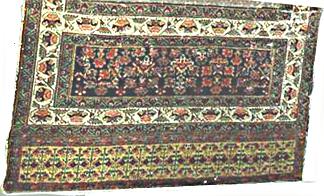 A detailed comparison of the
panels on your piece with that shown at ACOR reveals even greater
similarity, even though the structures are completely different. A detailed comparison of the
panels on your piece with that shown at ACOR reveals even greater
similarity, even though the structures are completely different. 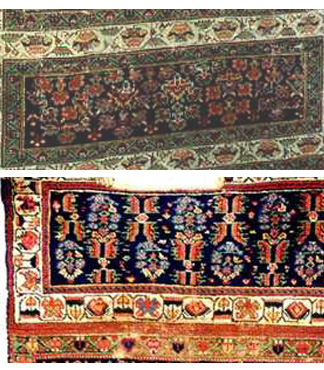 Of course, we don't know how large
your piece may have been at one time. The ends and sides of the one shown
at ACOR were more or less original, although bits of the now missing "end
panels" had been scavenged for repairs. The portion you see is as it was
woven. Without further information from you and without what we might
imagine is the rest of the original weaving, we cannot conclude that yours
is also a "box cover," but that is certainly possible. I don't think it is
a mafrash or any other form of bag or storage container, but others may
have a different opinion. Nor do I think it is a wagireh (also speculated
for the ACOR piece). Mafrash were made primarily by the Shahsavan, the
Bakhtiyari and certain Central Asian groups. I cannot recall ever having
seen a Kurdish mafrash, nor a Turkish one nor a Turkmen one. The border of
your example bears some resemblance to borders found in South Persian rugs
and bags, but almost the same border appears in a finely woven group of
Hamadan rugs having realistic bowls of fruit. Such designs are, of course,
highly mobile, so we tread on a slippery slope if we try to make our
attribution solely on the appearance of one border. Nevertheless, it is
safe to say that your mystery rug has a main border that is reasonably
well known in Northwest Persian in almost exactly this format. Based on
the similarity of the border, the stripes, the botehs and other aspects of
your piece, Northwest Persian certainly seems logical, perhaps more
specifically around Sanandaj or Hamadan. If it were ultimately believed
that your piece is a box cover, then we must reconsider the accuracy of
our terminology when we refer to weavings as "tribal" or "nomadic" or
"village" or "city" products. Often we assume that a coarsely woven, loose
handled, vibrantly colored weaving falls within the nomadic or tribal
category simply because of its construction. If, and this is a big IF,
your is a box cover intended for use by sedentary peoples, the entire
relationship between structure and nomadism comes into question. Of
course, we need look no further than the vast majority of Caucasian rugs
woven in cottage industries that have for decades been erroneously
referred to as tribal or nomadic simply because they are coarsely (and
less expensively) woven. Whether the box cover theory is or is not
accepted, your mystery rug illustrates just how limited we often are in
our knowledge and understanding of large groups of weavings and that our
incremental knowledge is generally advanced only in excruciatingly small
steps. Congratulations on another interesting Salon. Best,
Wendel Of course, we don't know how large
your piece may have been at one time. The ends and sides of the one shown
at ACOR were more or less original, although bits of the now missing "end
panels" had been scavenged for repairs. The portion you see is as it was
woven. Without further information from you and without what we might
imagine is the rest of the original weaving, we cannot conclude that yours
is also a "box cover," but that is certainly possible. I don't think it is
a mafrash or any other form of bag or storage container, but others may
have a different opinion. Nor do I think it is a wagireh (also speculated
for the ACOR piece). Mafrash were made primarily by the Shahsavan, the
Bakhtiyari and certain Central Asian groups. I cannot recall ever having
seen a Kurdish mafrash, nor a Turkish one nor a Turkmen one. The border of
your example bears some resemblance to borders found in South Persian rugs
and bags, but almost the same border appears in a finely woven group of
Hamadan rugs having realistic bowls of fruit. Such designs are, of course,
highly mobile, so we tread on a slippery slope if we try to make our
attribution solely on the appearance of one border. Nevertheless, it is
safe to say that your mystery rug has a main border that is reasonably
well known in Northwest Persian in almost exactly this format. Based on
the similarity of the border, the stripes, the botehs and other aspects of
your piece, Northwest Persian certainly seems logical, perhaps more
specifically around Sanandaj or Hamadan. If it were ultimately believed
that your piece is a box cover, then we must reconsider the accuracy of
our terminology when we refer to weavings as "tribal" or "nomadic" or
"village" or "city" products. Often we assume that a coarsely woven, loose
handled, vibrantly colored weaving falls within the nomadic or tribal
category simply because of its construction. If, and this is a big IF,
your is a box cover intended for use by sedentary peoples, the entire
relationship between structure and nomadism comes into question. Of
course, we need look no further than the vast majority of Caucasian rugs
woven in cottage industries that have for decades been erroneously
referred to as tribal or nomadic simply because they are coarsely (and
less expensively) woven. Whether the box cover theory is or is not
accepted, your mystery rug illustrates just how limited we often are in
our knowledge and understanding of large groups of weavings and that our
incremental knowledge is generally advanced only in excruciatingly small
steps. Congratulations on another interesting Salon. Best,
Wendel |
 The approximately 3.5' x 6' rug was
woven on a cotton foundation with depressed warps and the handle of a thin
floor carpet woven in a Northwest Persian town or city. The panelist could
agree that it was probably around 100 years old and that it was something
in the Sarouk family, but no consensus could be found on its function.
Suggestions were made that it could be a mafrash, but the size, shape and
number of the panels, the lack of wear in folded areas, and the nature of
its construction precluded a definitive mafrash denomination. Even more
curious was the fact that while it lacked wear where one would expect it
in a mafrash, it had been repaired in precisely those places where one
would expect damage from a closure system (as one would find on a
mafrash). Because of the relative lack of ornamentation in the center
panel, the suggestion was made that it served either as a sofreh or as a
ru-korssi or some other form of rug onto which some object or furniture
would have been placed. But no agreement could be found on that theory
either. Surprisingly, neither Taher Sabahi nor Parviz Tanavoli could
identify its use. Finally, someone in the audience relieved the panelists
of their agony by saying that he had owned a similar, but intact, piece,
which had end panels much like a mafrash. Its purpose, however, was not
transport or storage, but to cover some form of a wooden box with the
"bottom" covering the top of the box - much as some of us may now display
our mafrash. The format of your fragment (if, indeed, it is only
fragmentary) is quite similar to one end of the box cover shown at ACOR.
The approximately 3.5' x 6' rug was
woven on a cotton foundation with depressed warps and the handle of a thin
floor carpet woven in a Northwest Persian town or city. The panelist could
agree that it was probably around 100 years old and that it was something
in the Sarouk family, but no consensus could be found on its function.
Suggestions were made that it could be a mafrash, but the size, shape and
number of the panels, the lack of wear in folded areas, and the nature of
its construction precluded a definitive mafrash denomination. Even more
curious was the fact that while it lacked wear where one would expect it
in a mafrash, it had been repaired in precisely those places where one
would expect damage from a closure system (as one would find on a
mafrash). Because of the relative lack of ornamentation in the center
panel, the suggestion was made that it served either as a sofreh or as a
ru-korssi or some other form of rug onto which some object or furniture
would have been placed. But no agreement could be found on that theory
either. Surprisingly, neither Taher Sabahi nor Parviz Tanavoli could
identify its use. Finally, someone in the audience relieved the panelists
of their agony by saying that he had owned a similar, but intact, piece,
which had end panels much like a mafrash. Its purpose, however, was not
transport or storage, but to cover some form of a wooden box with the
"bottom" covering the top of the box - much as some of us may now display
our mafrash. The format of your fragment (if, indeed, it is only
fragmentary) is quite similar to one end of the box cover shown at ACOR.
 A detailed comparison of the
panels on your piece with that shown at ACOR reveals even greater
similarity, even though the structures are completely different.
A detailed comparison of the
panels on your piece with that shown at ACOR reveals even greater
similarity, even though the structures are completely different.  Of course, we don't know how large
your piece may have been at one time. The ends and sides of the one shown
at ACOR were more or less original, although bits of the now missing "end
panels" had been scavenged for repairs. The portion you see is as it was
woven. Without further information from you and without what we might
imagine is the rest of the original weaving, we cannot conclude that yours
is also a "box cover," but that is certainly possible. I don't think it is
a mafrash or any other form of bag or storage container, but others may
have a different opinion. Nor do I think it is a wagireh (also speculated
for the ACOR piece). Mafrash were made primarily by the Shahsavan, the
Bakhtiyari and certain Central Asian groups. I cannot recall ever having
seen a Kurdish mafrash, nor a Turkish one nor a Turkmen one. The border of
your example bears some resemblance to borders found in South Persian rugs
and bags, but almost the same border appears in a finely woven group of
Hamadan rugs having realistic bowls of fruit. Such designs are, of course,
highly mobile, so we tread on a slippery slope if we try to make our
attribution solely on the appearance of one border. Nevertheless, it is
safe to say that your mystery rug has a main border that is reasonably
well known in Northwest Persian in almost exactly this format. Based on
the similarity of the border, the stripes, the botehs and other aspects of
your piece, Northwest Persian certainly seems logical, perhaps more
specifically around Sanandaj or Hamadan. If it were ultimately believed
that your piece is a box cover, then we must reconsider the accuracy of
our terminology when we refer to weavings as "tribal" or "nomadic" or
"village" or "city" products. Often we assume that a coarsely woven, loose
handled, vibrantly colored weaving falls within the nomadic or tribal
category simply because of its construction. If, and this is a big IF,
your is a box cover intended for use by sedentary peoples, the entire
relationship between structure and nomadism comes into question. Of
course, we need look no further than the vast majority of Caucasian rugs
woven in cottage industries that have for decades been erroneously
referred to as tribal or nomadic simply because they are coarsely (and
less expensively) woven. Whether the box cover theory is or is not
accepted, your mystery rug illustrates just how limited we often are in
our knowledge and understanding of large groups of weavings and that our
incremental knowledge is generally advanced only in excruciatingly small
steps. Congratulations on another interesting Salon. Best,
Wendel
Of course, we don't know how large
your piece may have been at one time. The ends and sides of the one shown
at ACOR were more or less original, although bits of the now missing "end
panels" had been scavenged for repairs. The portion you see is as it was
woven. Without further information from you and without what we might
imagine is the rest of the original weaving, we cannot conclude that yours
is also a "box cover," but that is certainly possible. I don't think it is
a mafrash or any other form of bag or storage container, but others may
have a different opinion. Nor do I think it is a wagireh (also speculated
for the ACOR piece). Mafrash were made primarily by the Shahsavan, the
Bakhtiyari and certain Central Asian groups. I cannot recall ever having
seen a Kurdish mafrash, nor a Turkish one nor a Turkmen one. The border of
your example bears some resemblance to borders found in South Persian rugs
and bags, but almost the same border appears in a finely woven group of
Hamadan rugs having realistic bowls of fruit. Such designs are, of course,
highly mobile, so we tread on a slippery slope if we try to make our
attribution solely on the appearance of one border. Nevertheless, it is
safe to say that your mystery rug has a main border that is reasonably
well known in Northwest Persian in almost exactly this format. Based on
the similarity of the border, the stripes, the botehs and other aspects of
your piece, Northwest Persian certainly seems logical, perhaps more
specifically around Sanandaj or Hamadan. If it were ultimately believed
that your piece is a box cover, then we must reconsider the accuracy of
our terminology when we refer to weavings as "tribal" or "nomadic" or
"village" or "city" products. Often we assume that a coarsely woven, loose
handled, vibrantly colored weaving falls within the nomadic or tribal
category simply because of its construction. If, and this is a big IF,
your is a box cover intended for use by sedentary peoples, the entire
relationship between structure and nomadism comes into question. Of
course, we need look no further than the vast majority of Caucasian rugs
woven in cottage industries that have for decades been erroneously
referred to as tribal or nomadic simply because they are coarsely (and
less expensively) woven. Whether the box cover theory is or is not
accepted, your mystery rug illustrates just how limited we often are in
our knowledge and understanding of large groups of weavings and that our
incremental knowledge is generally advanced only in excruciatingly small
steps. Congratulations on another interesting Salon. Best,
Wendel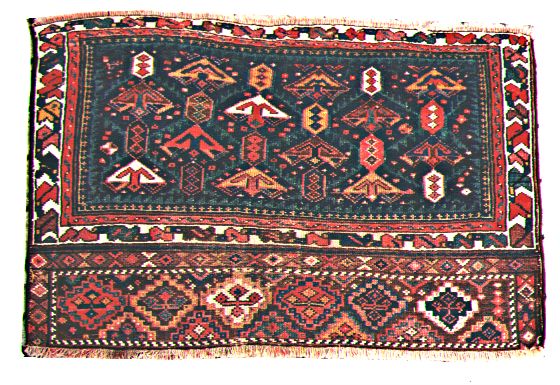
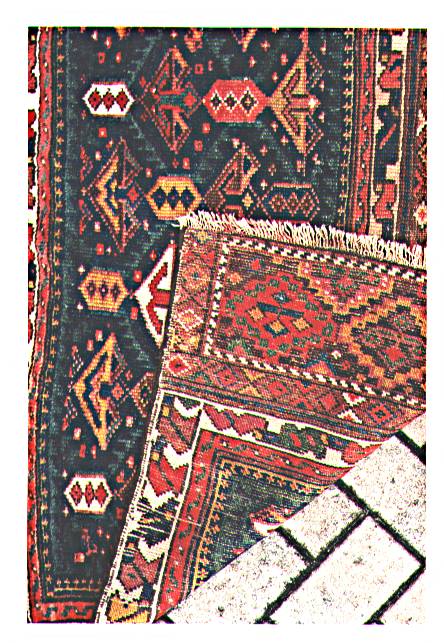 Origin: NW Iran Size: 3'7" x 4'2"
Warp: Ivory wool Z2S Weft: Ivory wool Knot: Symmetric (Turkish)
Reselvedged Dyes: Vegetal and synthetic red-orange (i.e., a hot, though
not entirely obnoxious orange. Condition: Added selvedge, slight wear to
the skirt area of the field. The knot count roughly 8 x 7 or 56 per sq in.
Regards, Kenneth Thompson
Origin: NW Iran Size: 3'7" x 4'2"
Warp: Ivory wool Z2S Weft: Ivory wool Knot: Symmetric (Turkish)
Reselvedged Dyes: Vegetal and synthetic red-orange (i.e., a hot, though
not entirely obnoxious orange. Condition: Added selvedge, slight wear to
the skirt area of the field. The knot count roughly 8 x 7 or 56 per sq in.
Regards, Kenneth Thompson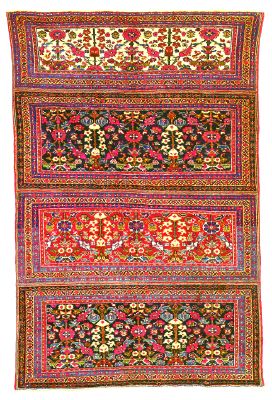
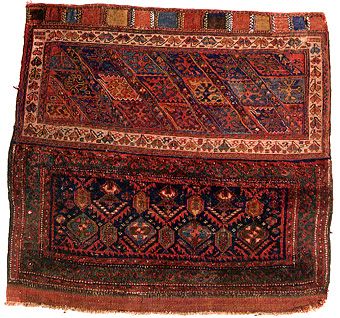 The front face, the upper
part in this picture is in diagonal soumak weaving, with a typical Persian
slits and loops closure system and the slits are edged with vertical
wrapped and bound borders. The second panel, very similar to the piece
shown by Kenneth Thompson with geometric flowers within a lattice, is
knotted. It was originally folded up and had loops. The second related
piece, plate 49, is a bagface measuring 2’2" x 2’5". This bagface has
exactly the same design as mine. Same borders, same two panels, same
colour palette, and a related structure.
The front face, the upper
part in this picture is in diagonal soumak weaving, with a typical Persian
slits and loops closure system and the slits are edged with vertical
wrapped and bound borders. The second panel, very similar to the piece
shown by Kenneth Thompson with geometric flowers within a lattice, is
knotted. It was originally folded up and had loops. The second related
piece, plate 49, is a bagface measuring 2’2" x 2’5". This bagface has
exactly the same design as mine. Same borders, same two panels, same
colour palette, and a related structure. 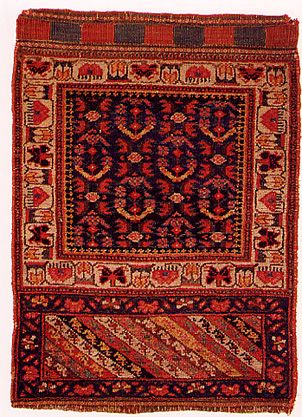 As few Kurdish rugs have
been attributed to specific Kurdish groups, O’Bannon, tentatively
attributes these and six others published in his book to the Sanjabi
Kurds. He says : "The items tentatively labelled Sanjabi Kurd have several
features which separate them from Jaf and other Kurdish weavings. 1/ No
offset knotting 2/ a usual blue red palette, but almost combined with a
good green, yellow and purple. 3/ White, ivory, beige wool warps 4/ Mostly
red wool wefts – two or more picks 5/mostly Persian patterns, but with a
specific two panel geometric design 6/edges usually overcast in red wool
7/in soumak weaving a 45° diagonal wrapping Thanks, Daniel
Deschuyteneer
As few Kurdish rugs have
been attributed to specific Kurdish groups, O’Bannon, tentatively
attributes these and six others published in his book to the Sanjabi
Kurds. He says : "The items tentatively labelled Sanjabi Kurd have several
features which separate them from Jaf and other Kurdish weavings. 1/ No
offset knotting 2/ a usual blue red palette, but almost combined with a
good green, yellow and purple. 3/ White, ivory, beige wool warps 4/ Mostly
red wool wefts – two or more picks 5/mostly Persian patterns, but with a
specific two panel geometric design 6/edges usually overcast in red wool
7/in soumak weaving a 45° diagonal wrapping Thanks, Daniel
Deschuyteneer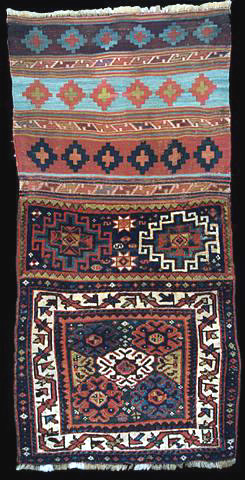 The nearly square proper "face"
of the bag matches the flat-woven and nearly square "back" with the pile
bottom panel acting to resist abrasion where it is most likely to occur.
In plate 209 of his seminal work Shahsavan, Parviz Tanavoli shows a
complete khordjin (attributed to the Shahsavan of Varamin) with sumak
faces and a pile bottom panel that is functionally identical to the
McDonald bag and to the second bag that Daniel posted on May 15 (although
in the latter the flat-woven back is missing). We know that the
Bakhtiyaris and the Lors produced many flat-woven khordjin or chanteh bags
with pile bottom panels, some of them with faces twice as wide as they are
high, just as in Daniel's example. Some of those bottom panels are
"I"-shaped to provide extra protection at the corners while some are
simply rectangular. Best regards, Wendel
The nearly square proper "face"
of the bag matches the flat-woven and nearly square "back" with the pile
bottom panel acting to resist abrasion where it is most likely to occur.
In plate 209 of his seminal work Shahsavan, Parviz Tanavoli shows a
complete khordjin (attributed to the Shahsavan of Varamin) with sumak
faces and a pile bottom panel that is functionally identical to the
McDonald bag and to the second bag that Daniel posted on May 15 (although
in the latter the flat-woven back is missing). We know that the
Bakhtiyaris and the Lors produced many flat-woven khordjin or chanteh bags
with pile bottom panels, some of them with faces twice as wide as they are
high, just as in Daniel's example. Some of those bottom panels are
"I"-shaped to provide extra protection at the corners while some are
simply rectangular. Best regards, Wendel